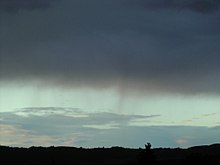Virga


In meteorology, virga is an observable streak or shaft of precipitation that falls from a cloud but evaporates or sublimates before reaching the ground.[1] A shaft of precipitation which does not evaporate before reaching the ground is a precipitation shaft. At high altitudes the precipitation falls mainly as ice crystals before melting and finally evaporating; this is often due to compressional heating, because the air pressure increases closer to the ground. It is very common in the desert and in temperate climates. In North America, it is commonly seen in the Western United States and the Canadian Prairies. It is also very common in the Middle East, Australia and North Africa.
Virga can cause varying weather effects, because as rain is changed from liquid to vapor form, it removes heat from the air due to the high heat of vaporization of water. Precipitation falling into these cooling down drafts may eventually reach the ground. In some instances, these pockets of colder air can descend rapidly, creating a wet or dry microburst which can be extremely hazardous to aviation. Conversely, precipitation evaporating at high altitude can compressionally heat as it falls, and result in a gusty downburst which may substantially and rapidly warm the surface temperature. This fairly rare phenomenon, a heat burst, also tends to be of exceedingly dry air.
Virga also has a role in seeding storm cells whereby small particles from one cloud are blown into neighboring supersaturated air and act as nucleation particles for the next thunderhead cloud to begin forming.[citation needed]
The word is derived from Latin virga meaning "twig" or "branch".
Extraterrestrial occurrences
Sulfuric acid rain in the atmosphere of Venus evaporates before reaching the ground due to the high heat near the surface.[2] Similarly, virga happens on gas giant planets such as Jupiter. In September 2008 NASA's Phoenix lander discovered a snow variety of virga falling from Martian clouds.[3]
See also
References
- ^ Glossary of Meteorology. American Meteorological Society. 2000. ISBN 1-878220-34-9.
- ^ "Planet Venus: Earth's 'evil twin'". BBC News. 7 November 2005.
- ^ "NASA Mars Lander Sees Falling Snow, Soil Data Suggest Liquid Past". 2008-09-29. Retrieved 2008-10-03.
External links
- National Science Digital Library - Virga
- "Viewing the Vagaries and Verities of Virga" Alistair B. Fraser and Craig F. Bohren, Department of Meteorology, The Pennsylvania State University, University Park, Pennsylvania, 2 November 1992 and 25 January 1993.
